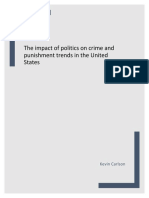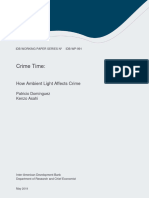Crime in Nyc
Crime in Nyc
Uploaded by
api-236690496Copyright:
Available Formats
Crime in Nyc
Crime in Nyc
Uploaded by
api-236690496Original Title
Copyright
Available Formats
Share this document
Did you find this document useful?
Is this content inappropriate?
Copyright:
Available Formats
Crime in Nyc
Crime in Nyc
Uploaded by
api-236690496Copyright:
Available Formats
Running Head: CRIME IN NEW YORK CITY
Meagan Cavanagh Crime in New York City Molloy College
CRIME IN NEW YORK CITY Crime, defined by the Merriam-Webster dictionary is, An act or the commission of an act
that is forbidden or the omission of a duty that is commanded by a public law and that makes the offender liable to punishment by that law (Merriam-Webster, 2013). Crime rates in New York City have significantly dropped since 1963, when accurate statistics began to be recorded (Parascandola, 2010).
Comparing homicide statistics from 1990 to 2009, the five cities with the largest populations: New York City, Philadelphia, Houston, Chicago, and Los Angeles, have had a significant decline in their murder rates. New York City went from having the highest homicide rates out of the five cities to the lowest (Zimring, 2012). Many believe that the dramatic decline in crime was due to the New York City Police Departments quality of life policing, as well as Compstat (Kelling). Compstat, short for Computer Comparison Statistics, is used to manage police operations. Although it is used in different law enforcement environments, in a police situation, numbers are analyzed and the location of crimes and arrests, as well as victims, suspects, days, and times of criminal activity are also recorded. These factors are all used to generate and identify crime patterns, clusters, suspects, and areas of high crime activity. Compstat can be described as a two-pronged examination of police operations. The first prong looks at crime and the effect it has on the community. The second prong observes the internal organization to identify the best practices in managing the police workforce, as well as risk management issues. The most important role of a police chief is to set objectives and goals for his team. There are four basic principles of Compstat: Accurate and timely intelligence, effective tactics, rapid deployment, and relentless follow-up and assessment. It is an organized method and a path to
CRIME IN NEW YORK CITY successful problem solving. However, this method is only one building block in any force that incorporates this into their repertoire (Godown, 2009).
There have been many great efforts that have been made in order to increase the effectiveness of policing and to decrease crime rates. One of these efforts is the four million dollar Edward Byrne Memorial Justice Assistance Grant (JAG). Charles Schumer and Kristen Gillibrand announced this award on September 4, 2013. This initiative is focused on making New York City a safer place and will support a wide range of programs including prosecution efforts to target violent offenders, crime prevention, education efforts, drug treatment and other alternatives to incarceration, victim and witness support, and improvement in technology. The grant will be directed towards the District Attorneys initiatives to target thieves, parolees, ganginvolved youth, violent gangs, career criminals, drug traffickers, and hate crimes (Congressional Documents and Publications, 2013). Schumer stated that, This investment will help make our streets and neighborhoods safer for children, families, and seniors. When it comes to protecting our citizens we must be tough and smart, and this federal investment will help New York City improve the public safety system (Congressional Documents and Publications, 2013). This program honors Eddie Byrne, a 22-year-old NYPD officer who was killed while protecting a witness. This grant helps to support local government to support activities used to combat and prevent crime (Congressional Documents and Publications, 2013).
New York City has reported a 32% decrease in felony crime rate as well as the number of prisoners behind bars following Mayor Michael Bloomberg taking office. Also, the incarceration rate is 27% lower than the national average (NYC Incarceration, 2013).
CRIME IN NEW YORK CITY Bloomberg stated that, Policing strategies that reduce crime have the added benefit of dramatically reducing incarceration in New York City (NYC Incarceration, 2013). Criminal justice experts believe that although policing and commitment to jail alternatives were factors in
the lowering of the imprisonment rates, the actual reason as to why there have been lower felony rates is unknown. Crime rates have dramatically decreased nationally as well as internationally despite having different tactics (NYC Incarceration, 2013).
Even through the significant drop in the economy, crime rates are still at an all time low. Twenty years ago, this could not be foreseen. Subways, parks, Grand Central Terminal are all examples of places that used to be crawling with criminals. In 2013, these are places that everyone can now feel safe. While on the subway, the fear has lessened throughout the commuters. They do not fear being mugged and assaulted. Now, Bryant Park is filled with children laughing and playing when it once used to be a drug hot spot. Grand Central Terminal is no longer a flophouse. These changes did not come easy however. There were many strategic plans that were enacted in order to consciously make New York City a safer place for its residents and visitors (Kelling).
Throughout my time in the city, there was never a point that I did not feel safe. I took the subway by myself, which is not something I would ever do normally, and not once did I feel as though I was in danger. Walking through the parks, I could see how there were a few characters that hung out there, but as long as you paid them no mind, they did not usually bother anyone. New York City is a beautiful place and through this experience I was able to see many things I did not even know existed. I can now fully appreciate what New York City truly has to offer.
CRIME IN NEW YORK CITY References Godown, J. (2009, August). The Police Chief. Retrieved October 18, 2013, from
www.policechiefmagazine.org/magazine/index.cfm?fuseaction=display&article_id=1859&issue _id=82009 Kelling, G. (n.d.). How New York Became Safe: The Full Story by George L. Kelling, City Journal 17 July 2009. Retrieved October 17, 2013, from http://www.cityjournal.org/2009/nytom_ny-crime-decline.html NYC Incarceration, Crime Both Down; Can Mayor Rightfully Claim Credit? (2013). Corrections Forum, 22(1), 12. Retrieved from http://search.proquest.com.molloy.idm.oclc.org/docview/1313203121?accountid=28076 Parascandola, R. (2010, January 5). 2009 homicides in New York City are fewest since 1963 - NY Daily News. Retrieved October 18, 2013, from http://www.nydailynews.com/news/crime/2009homicides-new-york-city-fewest-1963-article-1.457879 Schumer, gillibrand announce new york city set to receive over $4 million in DOJ grant; investment will help improve public safety in NYC. (2013). (). Lanham: Federal Information & News Dispatch, Inc. Retrieved from http://search.proquest.com.molloy.idm.oclc.org/docview/1430265138?accountid=28076 Zimring, F. (2013, June 13). How New York Beat Crime | OUPblog. Retrieved October 18, 2013, from http://blog.oup.com/2012/06/zimring-scientific-american-nyc-beat-crime/
You might also like
- Precision Policing 2.0Document31 pagesPrecision Policing 2.0Lexipol_Media_Group100% (1)
- Character & Cops, 6th Edition: Ethics in PolicingFrom EverandCharacter & Cops, 6th Edition: Ethics in PolicingRating: 4 out of 5 stars4/5 (6)
- Liberty Kids QuestionsDocument166 pagesLiberty Kids Questionskaren100% (1)
- The Bad War - The Truth NEVER Taught About World War II by Mike KingDocument245 pagesThe Bad War - The Truth NEVER Taught About World War II by Mike KingMed1aN1ckNo ratings yet
- Marshall IMPDocument14 pagesMarshall IMPAylinNo ratings yet
- The Problem Background of The StudyDocument9 pagesThe Problem Background of The StudyBrayan CaceresNo ratings yet
- Week 4 Assignment - Modern Day Policing-CRJ 100-Strayer UniversityDocument6 pagesWeek 4 Assignment - Modern Day Policing-CRJ 100-Strayer UniversityTerry MwendwaNo ratings yet
- Jordan MUN Country ProfileDocument5 pagesJordan MUN Country ProfileRevathi PrasadNo ratings yet
- Dangerous Drugs Board Regulation No. 3Document9 pagesDangerous Drugs Board Regulation No. 3Junyvil TumbagaNo ratings yet
- A Punitive Bind - Policing Poverty and Neoliberalism in New York CityDocument47 pagesA Punitive Bind - Policing Poverty and Neoliberalism in New York CitydavidNo ratings yet
- The Change in New York City Policing StrategiesDocument10 pagesThe Change in New York City Policing Strategiesjmd6054No ratings yet
- CamerasDocument24 pagesCamerasapi-409691854No ratings yet
- Street Crime - WikipediaDocument16 pagesStreet Crime - WikipediaAk AsfandNo ratings yet
- Intertwining Public Morality Prosecutorial Discretion and PunisDocument48 pagesIntertwining Public Morality Prosecutorial Discretion and Punispc okNo ratings yet
- Carrots, Sticks and Broken WindowsDocument54 pagesCarrots, Sticks and Broken WindowsMilan LipovacNo ratings yet
- Running Header: Crime Data Manipulation/Case Study On Incarceration 1Document4 pagesRunning Header: Crime Data Manipulation/Case Study On Incarceration 1api-426230838No ratings yet
- Decreasing Crime in New York CityDocument5 pagesDecreasing Crime in New York Cityapi-228102374No ratings yet
- Arresting Justice Final 2 SmallDocument30 pagesArresting Justice Final 2 SmallwordophileNo ratings yet
- Paper 2Document8 pagesPaper 2api-236184309No ratings yet
- Loopholes in The Fourth Amendment: Predictive Policing and The Threat of Data Brokers - Flora TianDocument18 pagesLoopholes in The Fourth Amendment: Predictive Policing and The Threat of Data Brokers - Flora TiannurjNo ratings yet
- Dương Thị Thanh Nhàn - Final PaperDocument12 pagesDương Thị Thanh Nhàn - Final PaperDươngg Thanh NhànNo ratings yet
- Defunding The Police 5Document10 pagesDefunding The Police 5api-740509696No ratings yet
- 15 - 1-s2.0-S0094119098921143-mainDocument26 pages15 - 1-s2.0-S0094119098921143-mainbruno.barbosaNo ratings yet
- Political ThesisDocument7 pagesPolitical Thesisapi-395426654No ratings yet
- Crime Rate Thesis StatementDocument9 pagesCrime Rate Thesis Statementmariacampanitawashington100% (2)
- We Were Wrong About Stop and FriskDocument2 pagesWe Were Wrong About Stop and FriskalexamadorNo ratings yet
- Case - Does CompStat Reduce CrimeDocument4 pagesCase - Does CompStat Reduce CrimemulerstarNo ratings yet
- 1982 - On-Theory-and-Action-for-Corporate-Braithwaite y GeisDocument23 pages1982 - On-Theory-and-Action-for-Corporate-Braithwaite y GeisLorena VarelaNo ratings yet
- Crime and SocialDocument43 pagesCrime and SocialTeqwi Ghana PNo ratings yet
- Qns County DAQc Da Fall 2013 Frontlines Community EditionDocument34 pagesQns County DAQc Da Fall 2013 Frontlines Community EditionPeter J. MahonNo ratings yet
- Mimetic Theory, AI and Police SystemsDocument8 pagesMimetic Theory, AI and Police SystemsCarlos Mora BenavidesNo ratings yet
- Terror Alert ProofsDocument16 pagesTerror Alert ProofsPantera CentroAutomotivoNo ratings yet
- Kaba Yes, We Mean Literally Abolish The Police - The New York TimesDocument3 pagesKaba Yes, We Mean Literally Abolish The Police - The New York TimesLauren Gil HayesNo ratings yet
- Intelligence Led PolicingDocument7 pagesIntelligence Led Policingapi-346513016No ratings yet
- Broken Windows AnswerDocument3 pagesBroken Windows AnswerNelson G. SouzaNo ratings yet
- An Eye For An Eye in The Electronic Age - GaugingDocument19 pagesAn Eye For An Eye in The Electronic Age - GaugingxipixipiNo ratings yet
- BROKENWINDOWS FivecitysocialexperimentDocument51 pagesBROKENWINDOWS FivecitysocialexperimentMarcelo SampaioNo ratings yet
- A Contemporary Perspective7Document27 pagesA Contemporary Perspective7Arturo ArangoNo ratings yet
- Force Multiplier: People As A Policing ResourceDocument29 pagesForce Multiplier: People As A Policing ResourceJoshua AbogaNo ratings yet
- Paper 2 Stop and FriskDocument7 pagesPaper 2 Stop and Friskapi-264790980No ratings yet
- Rennison DodgeDocument19 pagesRennison DodgeEduardo RodriguesNo ratings yet
- Turns + Some BlocksDocument5 pagesTurns + Some BlocksTylerNo ratings yet
- Bayley, D. and Shearing, C. (1996) The Future of Policing'.Document23 pagesBayley, D. and Shearing, C. (1996) The Future of Policing'.ninayoung119No ratings yet
- CRIMINOLOGY Term PaperDocument8 pagesCRIMINOLOGY Term PaperSimonNo ratings yet
- Current Research On Technology and Trafficking - Technology and Human TraffickingDocument4 pagesCurrent Research On Technology and Trafficking - Technology and Human Traffickingpratap81912No ratings yet
- Crime Data Comparison PaperDocument5 pagesCrime Data Comparison PaperTommorraSheltonNo ratings yet
- Running Head: Measuring Crime Paper 1Document6 pagesRunning Head: Measuring Crime Paper 1Bobbi Jo EarlNo ratings yet
- Omt PP CPDocument44 pagesOmt PP CPFernandoAlvesNo ratings yet
- Crime Rate Inference With Big Data: Hongjian Wang, Daniel Kifer, Corina Graif, Zhenhui LiDocument10 pagesCrime Rate Inference With Big Data: Hongjian Wang, Daniel Kifer, Corina Graif, Zhenhui Li222011356No ratings yet
- GIS and Crime MappingDocument15 pagesGIS and Crime MappingThomas FowlerNo ratings yet
- Unit 8: Crime Reduction & Community SafetyDocument7 pagesUnit 8: Crime Reduction & Community SafetyFayyaz HussainNo ratings yet
- SDM Crime Article June 2012Document8 pagesSDM Crime Article June 2012api-121213589No ratings yet
- Rosenberg_PersonalDeterrenceofGun Violence_18 - TaggedDocument5 pagesRosenberg_PersonalDeterrenceofGun Violence_18 - TaggedhermelinebrtlNo ratings yet
- Modello San FranciscoDocument12 pagesModello San FranciscoSergio BontempelliNo ratings yet
- Crimeprevention ColonDocument60 pagesCrimeprevention ColonJohn Lester SuarezNo ratings yet
- Defensible Spaces in ArchitectureDocument6 pagesDefensible Spaces in ArchitectureZoya ZahidNo ratings yet
- Crime and LawDocument4 pagesCrime and Lawmegan parkNo ratings yet
- The Causes of Crime and Violence A Guide For EmpirDocument11 pagesThe Causes of Crime and Violence A Guide For EmpirIvan MendezNo ratings yet
- Week 2Document3 pagesWeek 2r66kbsksy2No ratings yet
- Crime Time How Ambient Light Affects Crime en enDocument73 pagesCrime Time How Ambient Light Affects Crime en enSiempre PositivosNo ratings yet
- My Essay Draft 2.1Document9 pagesMy Essay Draft 2.1Eileen GeogheganNo ratings yet
- Predictive Policing in California Elected Officials 2015 SummerDocument5 pagesPredictive Policing in California Elected Officials 2015 SummerRecordTrac - City of OaklandNo ratings yet
- Risk Terrain Modeling: Crime Prediction and Risk ReductionFrom EverandRisk Terrain Modeling: Crime Prediction and Risk ReductionRating: 5 out of 5 stars5/5 (1)
- EMILIO AGUINALDODocument16 pagesEMILIO AGUINALDOHeraaa SanchNo ratings yet
- Social Political Economic and Cultural Issues in Philippine HistoryDocument14 pagesSocial Political Economic and Cultural Issues in Philippine HistoryMichael AngelesNo ratings yet
- Balila Vs IACDocument1 pageBalila Vs IACKym HernandezNo ratings yet
- Trilateral Commission Membership ListDocument18 pagesTrilateral Commission Membership ListJeany SaltyNo ratings yet
- Anti Hazing LawDocument20 pagesAnti Hazing LawglaiNo ratings yet
- DOJ Letter to DEADocument1 pageDOJ Letter to DEACBS46 AtlantaNo ratings yet
- Notice: Self-Regulatory Organizations Proposed Rule Changes: Fixed Income Clearing Corp.Document1 pageNotice: Self-Regulatory Organizations Proposed Rule Changes: Fixed Income Clearing Corp.Justia.comNo ratings yet
- Macalintal v. Presidential Electoral TribunalDocument14 pagesMacalintal v. Presidential Electoral TribunalAK100% (1)
- Have They Delivered? Ipswich NewsDocument1 pageHave They Delivered? Ipswich NewsQuest NewspapersNo ratings yet
- 053 BANAT v. COMELEC 595 SCRA 477Document24 pages053 BANAT v. COMELEC 595 SCRA 477JNo ratings yet
- Acquisitive and Extinctive PrescriptionDocument1 pageAcquisitive and Extinctive PrescriptionFukyiro PinionNo ratings yet
- Family Law 2 Research PaperDocument12 pagesFamily Law 2 Research PaperGargi agarwalNo ratings yet
- Stat Construction Case Listing Suarez 2015Document5 pagesStat Construction Case Listing Suarez 2015anneNo ratings yet
- Gov Abbott Border StatementDocument1 pageGov Abbott Border StatementBob PriceNo ratings yet
- Double Taxation - Rates of WithholdingDocument6 pagesDouble Taxation - Rates of Withholdingunderstated1313100% (1)
- Fujiki vs. MarinayDocument4 pagesFujiki vs. MarinayAntonio Paolo AlvarioNo ratings yet
- السلطة التشريعية في النظام الجزائري من خلال آخر تعديل دستوري 2020Document10 pagesالسلطة التشريعية في النظام الجزائري من خلال آخر تعديل دستوري 2020ranianicha0No ratings yet
- Nur Alfin: Data Diri Pengalaman KerjaDocument1 pageNur Alfin: Data Diri Pengalaman KerjaAl TianshiNo ratings yet
- CMFR Philippine Press Freedom Report 2010Document100 pagesCMFR Philippine Press Freedom Report 2010Center for Media Freedom & ResponsibilityNo ratings yet
- SSC T-3 Neetu Singh v-1Document59 pagesSSC T-3 Neetu Singh v-1panyamnrNo ratings yet
- Poli CasesDocument158 pagesPoli CasesDianne MedianeroNo ratings yet
- Myron May Police Report Oct. 7Document3 pagesMyron May Police Report Oct. 7kschofieldNo ratings yet
- Sri Lanka and The Tamil Tigers - Conflict and Legitimacy - Shlomi Yass - 2014Document18 pagesSri Lanka and The Tamil Tigers - Conflict and Legitimacy - Shlomi Yass - 2014Girawa KandaNo ratings yet
- Solely Means Only Supreme Court On Scope of ExemptionDocument4 pagesSolely Means Only Supreme Court On Scope of ExemptionbasakevNo ratings yet
- Former Sixteenth (16) Division: Court of AppealsDocument2 pagesFormer Sixteenth (16) Division: Court of AppealsBrian del MundoNo ratings yet
- Tribal Registration FormDocument4 pagesTribal Registration FormturatengakauNo ratings yet

























































































